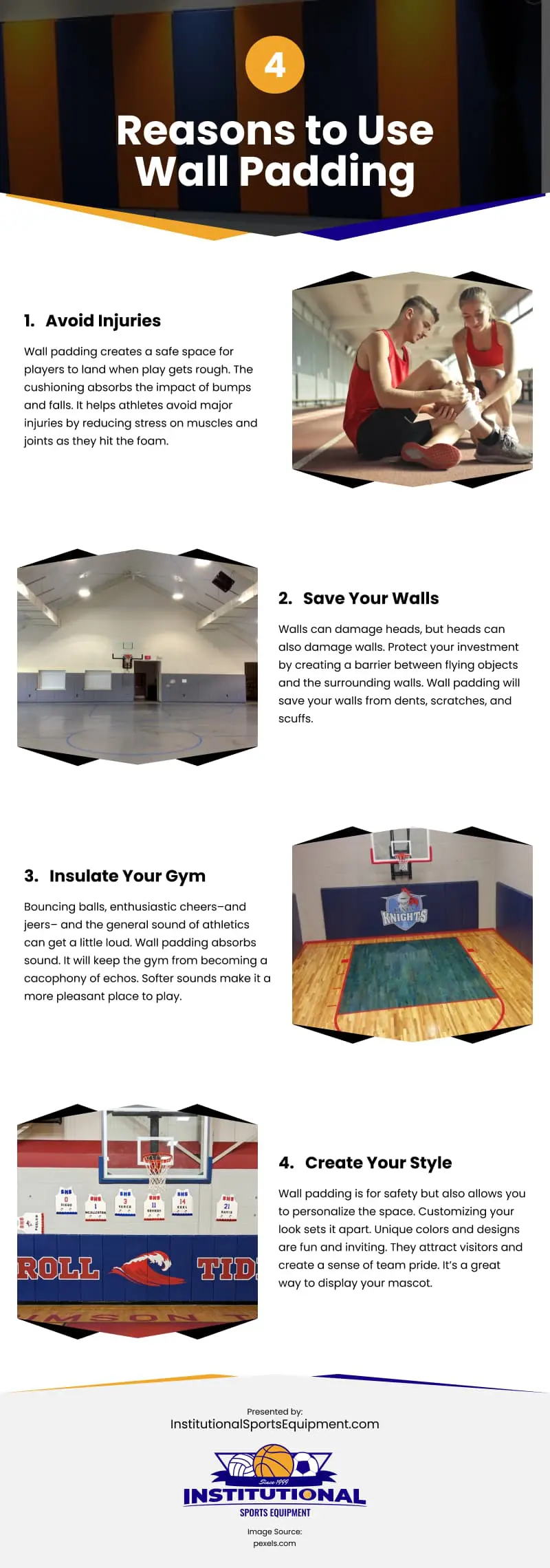Recreation is a fundamental value of our society. Whether it be spontaneous activities, city leagues, church teams, or school physical education classes, we love to play. Play is a great outlet for the pent-up stress and energy built throughout the day. Having a safe space to play is always ideal. As the owner or operator of a facility, creating that safe space for those recreating there falls to you. Adding padding to the walls is one step to protecting players.
Why Wall Padding?
Avoid Injuries
Wall padding creates a safe space for players to land when play gets rough. The cushioning absorbs the impact of bumps and falls. It helps athletes avoid major injuries by reducing stress on muscles and joints as they hit the foam. Many a head has been saved by falling into soft padding versus a hard exterior wall.
Save Your Walls
Walls can damage heads, but heads can also damage walls. Protect your investment by creating a barrier between flying objects and the surrounding walls. Wall padding will save your walls from dents, scratches, and scuffs.
Insulate Your Gym
Bouncing balls, enthusiastic cheers–and jeers– and the general sound of athletics can get a little loud. Wall padding absorbs sound. It will keep the gym from becoming a cacophony of echos. Softer sounds make it a more pleasant place to play. It also helps mask the ruckus to those outside of the gym, making the gym a better neighbor to offices, classrooms, and homes.
Create Your Style
Wall padding is for safety but also allows you to personalize the space. Customizing your look sets it apart. Unique colors and designs are fun and inviting. They attract visitors and create a sense of team pride. It’s a great way to display your mascot.
Tips For Choosing Quality Padding
Assess the Space
What activities do you host? Who are the athletes using it? Is it a smaller space, or do you have a large layout? The answers to these questions will determine the size and placement of your pads. The placement of current equipment like basketball goals and volleyball nets will tell you where you need padding in your space.
Standard wall padding panels are 2-feet wide by 6-feet tall, but custom sizes are also available. When choosing your padding keep in mind that replacing large custom pads is more costly than replacing a standard size wall pad due to damage. Also, smaller panels are less likely to droop and sag over time. Standard pads can hold their shape for years.
Any poles or columns should also be padded. These barriers are often more dangerous than walls. It’s essential to consider them as well.
Types of Foam
Foam saves the day. It absorbs shock and makes all the difference. Two types of foam are available. Polyurethane foam is lighter and softer. It is less compact and allows more movement upon impact. Polyethylene foam is more dense. It creates a firmer feel and provides more protection against big hits. It can help your wall padding last longer. No matter the material chosen, industry safety standards recommend having a pad with at least two inches of foam inside.
Structural Support
Foam padding needs a solid backing. Structural support is provided by wood paneling or a backer board. Wood backing gives your padding extra strength and keeps it from drooping with age and use.
Fire Safety
Keeping the gym up to fire code is a main priority. This includes using foam padding that incorporates fire-retardant materials. These specially formulated materials keep a fire from spreading quickly, saving lives and structural damage. When considering foam padding, ask your local fire marshall about the fire codes and regulations that apply to your facility. Having that information on hand will help with your decision.
Most wall pads do not contain fire retardant foam. They are wrapped in fire-resistant vinyl. This type of wall padding is sufficient for most applications. If you learn that you need class A rated wall padding, you will likely need to spend more for the added protection. Be sure you understand what type of materials are in your wall padding and have documentation of it. This information can help with insurance claims should a fire ever occur.
Vinyl Cover
Vinyl covers also protect your foam from the inevitable cuts, smears, and punctures that come from frequent contact. Higher quality vinyl will help the pads look nicer and last longer. Some vinyl even comes with antibacterial treatment. This prevents the growth of mold, mildew, and other bacteria that stem from damp gyms.
Custom printed indoor wall padding is the perfect way to customize your gym with a color, design, or unique logo. They add character to the space, showcase your team, and soften the sterile gym environment.
Choosing the Right Wall Padding
If you have been tasked with choosing and purchasing the best wall padding for your organization, you may feel a bit overwhelmed. The funds you have are precious and may be limited. You may feel like you need to become an expert in a new language overnight. We’re here to tell you that tackling the task one step at a time with an expert who knows wall padding doesn’t have to be complicated.
The key is to find a trusted sports equipment expert who understands how to protect your athletes. The right person can help with selecting the right wall padding and assist in planning the layout. They can help you work around tricky spots like outlets, windows, doors, and support columns. These are all key elements to the safety of your padding. They may even be able to recommend a local contractor to install the padding.
Whether you own a basketball court, martial arts facility, or indoor soccer gym, protective padding is an easy way to keep your players safe. Prioritizing high-quality wall pads also keeps you less liable for any injuries that happen under your roof. Knowing the right things to look for makes the process easier.
Infographic
Engaging in play helps release daily stress and energy. As a facility owner or operator, it’s your responsibility to provide a safe space for participants. Adding padding to the walls is one important step toward ensuring safety. Learn more in this infographic.


